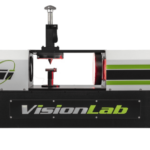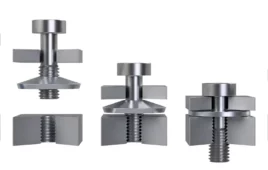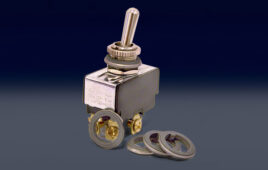Written by Michael Eusanio
Applications Engineer, Optimas Solutions
It’s common to assume a single part is stronger than an assembly of parts. However, fasteners can ensure the strength and reliability of a product, given certain considerations. For example, by tweaking the type of fastener material, size, or other specifications, manufacturing engineers can resolve torque, weight, stability, and durability concerns with no change to assembly or procedure.

The top and side views of a hardened and unhardened flat washer.
One such tweak: using hardened steel washers. Replacing standard washers with hardened steel means fasteners can be more reliably tightened. In fact, research shows these fasteners can be torqued with up to 50% higher clamping pressures, resolving bolt failure issues without making significant changes to the product design.
Mild steel is a generic low-carbon material used in typical washers and fastening systems. In comparison, unhardened steel is any steel material that has not undergone the hardening process. Understanding the difference between mild, low-carbon, and unhardened and hardened steel washers can make a difference in an engineer’s part design. The result: fastener assemblies that are more reliable, durable, and longer lasting.
Hardened vs. unhardened flat washers
Hardened flat washers are designed for assembly with a Grade 5 or higher strength bolt between the bearing surface of the fastener and the part to which it’s attached. These washers are carbon steel and can be through-hardened to Rc 38-45 or carburized (case hardened) to a minimum depth of .015“. They have a surface hardness of 37-45 Rc with a minimum core hardness of Rc 30.
Unhardened flat washers are designed for assembly with Grade 2 or lower strength bolts or tapping screws between the bearing surface of the fastener and the part to which it’s attached. Narrow (SAE) and wide (USS) flat washers are available for specification, depending on the required outside diameter.

The specifications of hardened flat washers.
The benefits
Hardened and unhardened flat washers offer several advantages in a fastener assembly, including:
• Protecting the mating surface from damage during assembly
• Improving the stress distribution on the mating surface
• Spanning larger clearance holes
• Providing a consistent bearing surface between the mating surfaces for torquing

The specifications of unhardened flat washers.
The standards
In hardened and unhardened flat washers, the dimensional characteristics are covered by ANSI B18.22.1*, and the mechanical properties are covered by ASTM F844. Both ANSI (the American National Standards Institute) and ASTM (formerly the American Society for Testing and Materials), develop and oversee technical standards.
Understanding the effect a washer has on the entire fastener solution and assembly is critical before deciding on the ideal match for an application. This includes the fastener material and the tool and torque used during installation.
A washer can be instrumental in adjusting torque — ultimately adding more strength and longevity to an assembly.









Tell Us What You Think!